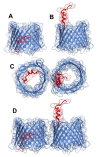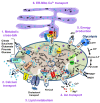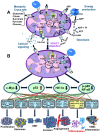VDAC1 at the crossroads of cell metabolism, apoptosis and cell stress
- PMID: 30542671
- PMCID: PMC6287957
- DOI: 10.15698/cst2017.10.104
VDAC1 at the crossroads of cell metabolism, apoptosis and cell stress
Abstract
This review presents current knowledge related to VDAC1 as a multi-functional mitochondrial protein acting on both sides of the coin, regulating cell life and death, and highlighting these functions in relation to disease. It is now recognized that VDAC1 does not only play a crucial role in regulating the metabolic and energetic functions of mitochondria. The location of VDAC1 at the outer mitochondrial membrane (OMM) allows the control of metabolic cross-talk between mitochondria and the rest of the cell and also enables its interaction with proteins involved in metabolic and survival pathways. Along with regulating cellular energy production and metabolism, VDAC1 is also involved in the process of mitochondria-mediated apoptosis by mediating the release of apoptotic proteins and interacting with anti-apoptotic proteins. VDAC1 functions in the release of apoptotic proteins located in the mitochondrion inter-membranal space via oligomerization to form a large channel that allows passage of cytochrome c and AIF and their release to the cytosol, subsequently apoptotic cell death. VDAC1 also regulates apoptosis via interactions with apoptosis regulatory proteins, such as hexokinase (HK), Bcl2 and Bcl-xL, some of which are also highly expressed in many cancers. This review also provide insight into VDAC1 function in Ca2+ homeostasis, oxidative stress, and presents VDAC1 as a hub protein interacting with over 100 proteins. Such interactions enable VDAC1 to mediate and regulate the integration of mitochondrial functions with cellular activities. VDAC1 can thus be considered as standing at the crossroads between mitochondrial metabolite transport and apoptosis and hence represents an emerging cancer drug target.
Keywords: Apoptosis; Cancer; Metabolism; Mitochondria; VDAC1.
Conflict of interest statement
Conflict of interest: The authors declare no conflict of interest.
Figures





Similar articles
-
The mitochondrial voltage-dependent anion channel 1 in tumor cells.Biochim Biophys Acta. 2015 Oct;1848(10 Pt B):2547-75. doi: 10.1016/j.bbamem.2014.10.040. Epub 2014 Nov 4. Biochim Biophys Acta. 2015. PMID: 25448878 Review.
-
VDAC1: from structure to cancer therapy.Front Oncol. 2012 Nov 29;2:164. doi: 10.3389/fonc.2012.00164. eCollection 2012. Front Oncol. 2012. PMID: 23233904 Free PMC article.
-
Voltage-Dependent Anion Channel 1 As an Emerging Drug Target for Novel Anti-Cancer Therapeutics.Front Oncol. 2017 Jul 31;7:154. doi: 10.3389/fonc.2017.00154. eCollection 2017. Front Oncol. 2017. PMID: 28824871 Free PMC article. Review.
-
VDAC1 functions in Ca2+ homeostasis and cell life and death in health and disease.Cell Calcium. 2018 Jan;69:81-100. doi: 10.1016/j.ceca.2017.06.007. Epub 2017 Jun 23. Cell Calcium. 2018. PMID: 28712506 Review.
-
VDAC1-Based Peptides as Potential Modulators of VDAC1 Interactions with Its Partners and as a Therapeutic for Cancer, NASH, and Diabetes.Biomolecules. 2024 Sep 9;14(9):1139. doi: 10.3390/biom14091139. Biomolecules. 2024. PMID: 39334905 Free PMC article. Review.
Cited by
-
Combining nano-differential scanning fluorimetry and microscale thermophoresis to investigate VDAC1 interaction with small molecules.J Enzyme Inhib Med Chem. 2023 Dec;38(1):2121821. doi: 10.1080/14756366.2022.2121821. J Enzyme Inhib Med Chem. 2023. PMID: 36650907 Free PMC article.
-
6-Hydroxydopamine Induces Neurodegeneration in Terminally Differentiated SH-SY5Y Neuroblastoma Cells via Enrichment of the Nucleosomal Degradation Pathway: a Global Proteomics Approach.J Mol Neurosci. 2022 May;72(5):1026-1046. doi: 10.1007/s12031-021-01962-z. Epub 2022 Mar 8. J Mol Neurosci. 2022. PMID: 35258800 Free PMC article.
-
Activation of Hippo signaling pathway mediates mitochondria dysfunction and dilated cardiomyopathy in mice.Theranostics. 2021 Aug 21;11(18):8993-9008. doi: 10.7150/thno.62302. eCollection 2021. Theranostics. 2021. PMID: 34522223 Free PMC article.
-
The Synthetic Flavonoid Derivative GL-V9 Induces Apoptosis and Autophagy in Cutaneous Squamous Cell Carcinoma via Suppressing AKT-Regulated HK2 and mTOR Signals.Molecules. 2020 Oct 30;25(21):5033. doi: 10.3390/molecules25215033. Molecules. 2020. PMID: 33143000 Free PMC article.
-
VDAC1: A Key Player in the Mitochondrial Landscape of Neurodegeneration.Biomolecules. 2024 Dec 30;15(1):33. doi: 10.3390/biom15010033. Biomolecules. 2024. PMID: 39858428 Free PMC article. Review.
References
Grants and funding
LinkOut - more resources
Full Text Sources
Other Literature Sources
Research Materials
Miscellaneous
